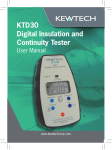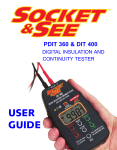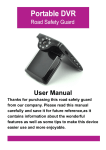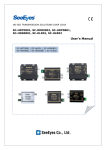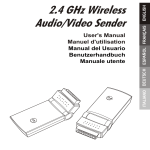Download Socket & See PDIT360 Technical Document - Stroma
Transcript
FREE Step-by-step guide to easy PART P Insulation and Continuity Testing using the PDIT 360 Issue no. 01/07 Insulation and Continuity Testing Introduction The PDIT 360 requires 4 x AA cells (alkaline type recommended) that must be inserted with correct polarity. ALWAYS REMOVE THE The PDIT 360 is a simple and rugged instrument for use by electrical installers in testing the continuity of electric cables as well as their insulation resistance. The tester is only for use on dead circuits and although fully protected against accidental connection to a live circuit, it always pays to to check that the circuit is dead TEST LEADS BEFORE REPLACING THE BATTERIES. Four full capacity alkaline AA cells are expected to have a life of 5000 tests at 500 V. Battery life is extended because the PDIT 360 captures the test result very quickly and will automatically switch off if not used for two or three minutes. before working on it. The safety check is fully explained in the Continuity Testing section headed “Continuity Testing”. The tester is equipped with a very useful “hands free” auto testing facility as described in the section headed “Hands Free Function”. Do not touch the test lead tips when this test mode is in use. All electrical circuits have a property called “capacitance”, its presence being indicated by the insulation test result taking longer than usual to appear. Capacitance may result in the test voltage being stored for a short time when testing insulation resistance. The PDIT 360 has a facility to automatically discharge The purpose here is to ensure that a circuit is continuous so that current will flow in it, and to measure its resistance. Before using the instrument, it is important to ensure that the circuit under test is not live. First switch off the supply at the main isolator in the consumers unit (See Fig 1) and then remove its cover (See Fig 2). 1 Turn off the isolator at the consumer unit this voltage, but do not disconnect the test leads until discharge is complete, usually in no more than a few seconds. Check the condition of the test leads and crocodile clips frequently. Socket & See replacement lead sets are inexpensive and easy to obtain. The continuity function is protected against accidental connection to the mains (an unlikely event as there is a built-in warning system. If the fuse does blow, replace it with the correct type which is Type F 500mA fast blow ceramic 500 V. It is located inside the battery compartment. 2 Remove the consumer unit cover 1 2 3 Live Circuit Warning Continuity Test 6 LCD Display Power ON/OFF (including Intelligent Auto Power Off) 4 Insulation Test 5 Insulation Test Voltage 250V 500V Continuity Test Lead Null 7 Next make sure that the system really is dead by switching the Briefly Push to Test (Instant) plus Push and Hold for 2 seconds for Auto Test (Hands Free) tester on and placing the probes carefully on the input terminals of the isolator (See Fig 3). The red WARNING VOLTAGE PRESENT indicator at the top of the front panel will flash and a warning tone 8 will be heard. Next remove the probes and reposition them on the output terminals of the isolator (See Fig 4). There should be no warning light or tone, indicating that safe continuity testing can commence. 3 Testing the live side of the main isolator Ring Circuit Continuity The ring circuit has become the standard method for wiring socket outlets and, as the name implies, is in the form of three complete rings commencing and finishing at the fuse or the circuit breaker for the circuit concerned. The method of wiring is most usually with twin and earth cables. The phase (often called the live) ring will probably consist of red conductors, although in new installations they will be brown. The neutral ring will consist of black (or new blue) cables, whist the earth ring will have Note red light and warning tone green/yellow conductors. It is important that all three of these rings are continuous and that the ring circuit has no cross connections, sometimes called “bridges” or “spiders”. There may be more than one ring circuit fed by the consumer unit, so first identify the one you wish to test. The consumers unit in 4 Verifying that the consumer unit is switched off Figs 1 and 2, for example, has ten miniature circuit breakers (MCBs), four of which are rated at 32 A. The first one feeds the cooker, whilst the other three provide protection for ring circuits. Switch off all four circuit breakers and identify the one feeding the circuit you are going to test. Disconnect all conductors from this circuit breaker, two reds (or browns), two blacks (or blues) and two green/yellows. If the installation is an old one, the earth conductors may be bare, but enclosed in green sleeving. Next connect the crocodile clips to the test leads and connect them together, when pressing the TEST button at the bottom of the instrument face will measure and display the resistance of the leads, (typically about 0.08Ω). This value will be constant and we will wish to discount it in all our future continuity measurements. The PDIT 360 will do this automatically if we press the button labelled NULL (Test Leads). The measured resistance of the test leads is then stored and is subtracted from all continuity readings taken until the tester is switched off. Hands free function Now we turn our attention to verifying the continuity of the rings The PDIT 360 has a very useful “hands free “ function allowing themselves. First, separate the two red (or brown) phase (or live) successive continuity measurements to be made without conductors, connecting each separately to one test lead crocodile continually pressing the TEST button. This is switched on by holding clip as shown in Fig 5. Pressing the TEST button will then measure the TEST button down for three seconds when in the CONTINUITY the resistance of the complete ring (minus the test lead resistance mode. A symbol appears on the display, the CONT symbol flashes that has been subtracted automatically by the tester). Thus the on and off and there is an intermittent “beep” tone to indicate continuity of the ring has been established. Repeat the test with that the hands free mode is active. Take care not to touch the tips the crocodile clips connected to the two neutral conductors (black of the test probes whilst the hands free system is active. The or blue) as shown in Fig 6. The results of this test should be much function can be switched off by pressing the ON/OFF button the same as those for the phase (or live) ring. Finally, test the earth twice, when the PDIT 360 will power up in the normal ring by connecting the crocodile clips separately to the green/yellow INSULATION TEST mode. conductors; the result here should normally be about half as much again as that for the other two rings already measured because the earth conductors have a lower cross section than those used for the live and neutral conductors. 7 Connection of phase and neutral conductors using unplugged crocodile clips for “absence of bridges” test 5 Measuring the phase (live) ring continuity Where the wiring is carried out using twin with earth cables, getting the correct conductors from opposite ends of the ring will be obvious. However, where the wiring consists of separate 6 Measuring the neutral ring continuity conductors in conduit, greater care must be taken to ensure that conductors connected together are from opposite ends of the ring. Next, go to each socket on the ring in turn and remove its fixing screws so that the connections are available as shown in Fig 8. Next test the resistance from phase (red or brown) to neutral (black or blue) using the test prods in place of the crocodile clips on the test leads (see Fig 9). 8 Socket removed for testing Now we must test to make sure that there are no “bridges” or “spiders”. This fault can occur if two spurs taken from different places on the ring are connected together. First, the red (or brown) conductor feeding the ring in one direction must be connected to the black (or blue) conductor feeding in the other direction. Then the other two conductors (red or brown and black or blue) are connected together in the same manner. The easiest way of making this connection is to unplug the crocodile clips and to use them to connect the conductors together as shown in Fig 7. Insulation and Continuity Testing 9 Checking for “bridges” at socket outlets proved. The exception here is sockets wired on spurs, where the readings may be slightly higher. If the readings increase or decrease as your tests progress round the ring, there is a wiring error and more experienced advice may be needed. On completing your ring circuit continuity tests, do not forget to reconnect the cables, as they were when you started. Lighting Circuits Lighting circuits are wired using radial, not ring, circuits, so they do not need testing for bridges or spiders. However, it is very important for safety reasons that switches are connected in the phase (live) conductor rather than in the neutral. The simplest way of testing this is to make a temporary connection at the consumers unit from the phase (live) (red or brown) to earth (green/yellow) There may be a large number of sockets on each ring, and this process will be time consuming. A much faster alternative is to use the Socket & See SS 130 Socket Adaptor that can be simply plugged in to the in situ socket to make the connections available (See Fig 10). as illustrated in Fig 11. 11 Temporary connection from phase to earth to facilitate correct lighting switch polarity testing 10 Using the SS 130 Socket Test Adaptor Using the new Socket and See interface eliminates the need to remove the socket from the wall saving time, reducing problems of broken connections and no damage to the customers decorations. Set the PDIT 360 to the continuity range and measure the resistance between each switch and earth. The value is not important as long as it is low (probably below 1 Ω) which will show that the switch is correctly installed in the phase conductor. A similar test should also be made between the centre contact of Edison screw lamp holders and earth to ensure that the lamp screw, which can be touched whilst removing the lamp, is not live. On completion of this test of lighting circuit continuity, do not forget to remove your temporary live to earth connection at the consumer unit. Insulation Resistance Testing The whole process must be repeated with the crocodile clips This test is to ensure that the insulation of the electrical system is connecting the phase (red or brown) and earth (green/yellow) adequate. No electrical insulators are perfect, and as a result a from opposite ends of the ring. small leakage current passes through them. The PDIT 360 applies a direct voltage of 500 V or of 250 V across the insulation, measures If the readings at all sockets are substantially the same for each of the two tests, the absence of bridges or spiders will have been the leakage current and calculates the insulation resistance. This resistance is usually very high and is measured in megohms (MΩ), which are millions of ohms. A direct, rather than an alternating voltage must be used, because due to an effect called capacitance 12 Testing insulation resistance with the PDIT 360 a very small leakage current flows, even in perfect insulation if the test voltage is alternating. Tests are necessary between phase (live) and neutral, between phase and earth and between neutral and earth. The minimum acceptable level for insulation resistance is 0.5 M Ω. However, this is a very low value and if the measured insulation resistance is less than 2 M Ω there may well be need for further investigation. The high direct voltage used for insulation resistance testing can damage electronic equipment, so it is important that vulnerable devices such as fluorescent fittings, passive infra-red detectors (PIRs), touch switches, dimmer switches, power controllers, delay Repeat the test with connections to phase and earth, and again timers, electr onic residual current devices (RCDs), etc. must be when connected to neutral and ear th. disconnected before testing takes place. The test voltages are high enough to give an electric shock to a person, but will not be lethal because the internal impedance of the instrument limits the shock current to internationally agreed safe levels. The Socket & See PDIT 360 will automatically select the 500 V test voltage when it is first switched on, and the voltage is displayed at The larger the system being tested, the more cable insulations there will be connected in parallel, and the lower will be the insulation resistance. Thus the measured insulation resistance of a single circuit (measured at its circuit breaker or fuse) would be expected to be higher than that of a complete electrical installation (measured at the supply intake position). the top of the panel. In some cases, such as low voltage lighting circuits, the lower test voltage of 250 V is required, and is selected by pressing the TEST VOLTS button, when “250 V” will appear in the display panel . To carry out an insulation test, first make sure that the supply is switched off as described under “continuity testing” at the beginning of this Guide. Plug the crocodile clips into the tests leads and then connect them to the phase and to the neutral of the installation or the circuit to be tested. Make sure that switches are off, or the reading will be the resistance of the connected loads rather than the insulation resistance. Keep your fingers clear of the connections and press the TEST button, when the insulation resistance will be displayed. (See Fig 12). Socket & See Industrial www.socketandsee.co.uk Unit 4, Century Road, High Carr Business Park, Newcastle, Staffordshire, UK, ST5 7UG T +44 (0)1782 567096 F +44 (0)1782 567095 NOTE: This document is intended as a Guide to Insulating and Continuity Testing only and reference should be made to the PDIT 360 User Manual for full operating instructions before any tests are undertaken.








